
ARCHIVED PAGE - PLEASE READ!
This page was written by me a long, long time ago. As such the quality of the writing, photography and/or any conclusions I may have come to simply do not stand up to the levels I consider necessary these days.
I do not believe in deleting things outright though as I feel that these pages form something of a time capsule from an earlier stage in my life, and may still be of some interest to folks who have been coming here for a long time. So instead of deleting this page it has been archived.
PLEASE NOTE THAT THIS PAGE HAS BEEN ARCHIVED, AND SHOULD BE CONSIDERED "FOR INTEREST ONLY" AND NOT BE USED FOR ANY OTHER PURPOSE. LINKS, PRICING ETC ARE LIKELY TO BE OUTDATED AND WILL NOT BE UPDATED.
LumaRay FL-6 - 2006. Rating: 86%

Just over a year on from the appearance of the original LumaRay FL6, I received an interesting email from them a couple of weeks back, announcing that a revised version was to appear for this year - and here it is. I thought then, that they would have to do something pretty special to better their original product...and it would seem, they have done just that. So, let's see what the FL6-2006 is all about...
Product Info:
| Manufacturer: |
|
| Available from: | Manufacturer's website. - Link removed as website is no longer active. |
| Price: | US$74.95 |
| Size: | 21.5 x 5.5cm |
| Number of lamps: | 6 |
| Lamp Type: | 5mm LED (Nichia CS series) with custom optics |
| Peak Beam intensity: | Greater than 600cd (manufacturers claim) |
| Total Luminous Flux: | Approximately 70Lm (manufacturers claim) |
| Lamp Current: | Unknown - to be measured |
| Lamp Colour: | White. |
| Body finishes available: | Plastic (GE Xenoy™) - Gunmetal colour. (Also available: White, black, two tone yellow-grey) |
| Battery type: | 3 C-size. Alkaline recommended. |
| Battery life: | 600 hours continuous, 15-20 hours at high brightness. |
| Switch Type: | Twist bezel on/off. No intermittent or lockout modes. |
| Water Resistance: | Waterproof. Submersible to 50 feet. |
| Approximate Beam angle: | Estimate - 5° |
| Notes: | Light is supplied with instruction manual only, no accessories are included. |
| Review Date: | 7th July 2006. |
| Related pages: | LumaRay FL-6 (2005 model) Review. |
First Impressions:

When you first receive your FL6, you'll know what it is right away - LumaRay are one of only two companies I know that package things in triangular prism shaped boxes - the other thing that comes in boxes of this shape of course being Toblerone chocolates.
Inside the innovative packing you will find, not as you may expect given the holes, something small fluffy and alive, but two sturdy plastic bags (which the vast majority of you WILL need scissors to get into unless you have claw-like fingernails such as mine), containing your brand shiny new flashlight, and its instruction manual.
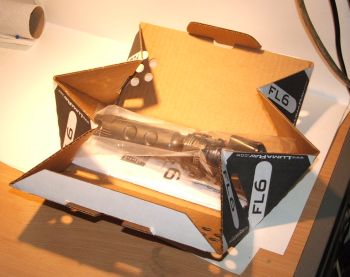
I'm glad to report that this is one of those packages that you do not have to tear into a million pieces to get into. Just
Cut through the two pieces of tape holding the box closed, pull the tab out, and unfold. It's a little mini cardboard-engineering marvel in itself.
Now, this bit's important...when you first pick the light up, prepare to be less than filled with confidence - without batteries in, it *feels* cheap and plasticy, quite simply because it weighs virtually nothing. Ignore that though, and wait to make judgments on the feel and balance of the light until you've put the batteries in.
Visually, the first impression you'll get is probably that this is the strangest (and in my opinion one of the coolest) looking flashlight that you've ever laid eyes on. Right from the techno-industrial sort of arrangement around the neck of the light, to the magnifying lens equipped head, it all looks like something right out of Star Wars...no point in dodging the issue...it looks like a light sabre! Especially in the deep gunmetal colour of this unit. The FL6-2006 is now available in a choice of colours unlike the original, which was only available in this gunmetal finish. White, black and a two-tone grey/yellow colour now make up the rest of the colour options.
These all have their place I think, the existing gunmetal finish was, and still is my favourite, just because it looks so smart. The black is a more purposeful version, designed more with use as an everyday tool in mind. The yellow/grey combination is certainly an interesting one, in my mind fitting in with the somewhat sci-fi styling rather well too, as well as being clearly more aimed at trades where high visibility is the order of the day. Finally, the new white colour deserves a mention, especially where individuality is concerned. Think about it, when is the last time you saw a white flashlight?
...aside from anything else, I think if in Star Wars, the Storm Troopers had light sabres...they'd look like the white FL6 in this photo does...but that's just me.

(Photograph above taken from a page on LumaRay's website, and is used with permission)
Powering up:
The FL6 is powered by three ordinary C size batteries (alkaline ones being recommended). The battery life from this light is generally best measured in geological terms...up to around 20 hours at high brightness...and running on steadily dimming for another, wait for it...600 or so hours. Granted, it will get dimmer over that time as no regulation circuit is used in this case - which I actually prefer. Twice now I've been left rummaging around in here in the dark by regulated lights that have all but gone out instantly when the batteries have expired. In an unregulated light such as this though, the light output just steadily drops away, giving you plenty of time (hours and hours in this case) to dig out some replacement batteries. To put this in context, my original LumaRay FL12, which I have had since July 2005 and used regularly, granted in fairly short bursts most of the time aside from when working on the car and one power cut is STILL running perfectly well on its original set of batteries...and the FL12 is MORE power hungry than the FL6...so you better take note of the instructions, you won't need them very often!
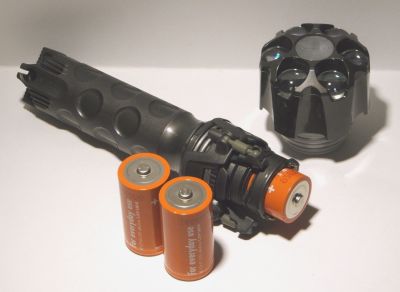
Batteries are not included with the light - presumably to reduce shipping costs as much as anything.
Like its predecessor, the FL6-2006 has a very unusual and very clever head release system. However, at first glance it's not the most self-explanatory piece of kit you'll ever have encountered. Here's how to get into it.
1. Stand the light on a flat surface (like a desk) with the bezel pointing up. Locate the locking collar - this is the thing with the three rods from the cantilever assembly attached to it - right at the top of the battery tube. Grip this and rotate it anti-clockwise. There's a pretty strong detent when it is the "locked" position. An improvement over the old design, where it tended to rotate of its own accord when turning the light on and off.
2. Get a decent hold of it, and press downward firmly (this is why it's easier to do on a desk - a reasonable amount of force is needed to compress that spring - yes, the one you can see. It is actually a functional component). The head should now lift itself a little if there are batteries installed, if not, while still holding the collar down, lift it off. You can tell how good the waterproofing is at this point, as there's an audible "thump" when you pull it off due to the slight vacuum you've produced in lifting the head up is equalised. This noise caused a very puzzled look from my cat who was watching from the bed at the time. Don't worry if yours does this, it's perfectly normal.
3. Dump out the old batteries if there are any in there. You may have to shake the light to get them out, as LumaRay have intentionally fitted an O-ring to stop the cells falling straight out. This may seem a bit of a faff initially - but trust me, if you've ever dropped C or D batteries on your bare toes when changing them in the dark, you'll realise what a good idea having them unable to fall out actually is! Sometimes the last one can be a pain to get out, some brands seem to take more effort to get out than others, but this can easily be overcome just by shaking the light somewhat more violently than for the other two, it'll drop out eventually.
4. Install three new C size batteries, negative end toward the tailcap. There's a decent spring in there, so you can safely drop the cells straight in without worrying about breaking anything.
5. Press the head back on - if it won't fit, rotate it through 30 degrees or so and try again. Very occasionally the switching assembly will line up incorrectly and prevent the head from fitting. This doesn't indicate a fault - just turn the head and try again. The head will click into place audibly when it's right on. It's best not to be looking into the light when doing this, as sometimes it'll switch on when you press the head into place depending on how things line up - and you don't want to be walking around staring at six green dots for the next half hour!
6. Rotate the locking ring found in step 1 clockwise until it clicks to lock everything up. Then you're good to go. When you're actually looking at the light, it seems rather more simple than it is to explain.

Switching on:
The FL6 is a very easy light to use. No really, I MEAN simple!
To get light, simply turn the head anticlockwise (with it facing away from you). Turn it clockwise to not get light again.
There are no signalling modes or lockout functions to be found on this light, so please do not bother looking for them. The lack of a dedicated lockout system is not a major issue in my mind here. The waterproofing seals mean that there is sufficient resistance when turning the head to prevent unwanted activation in all but the most unusual of circumstances. Even then - it's not as if you're going to burn through $10 of batteries in half an hour, as with some other lights on the market!
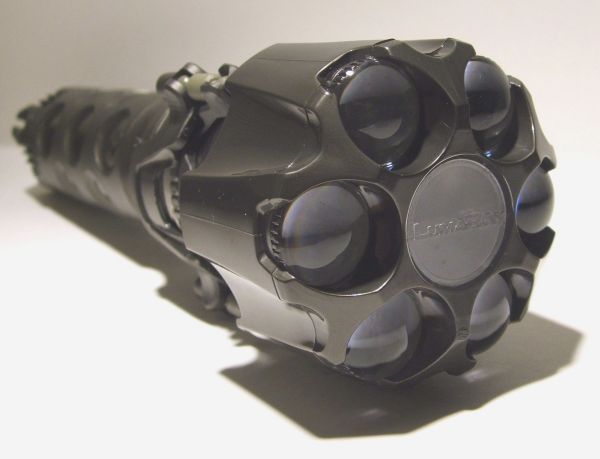
Performance:
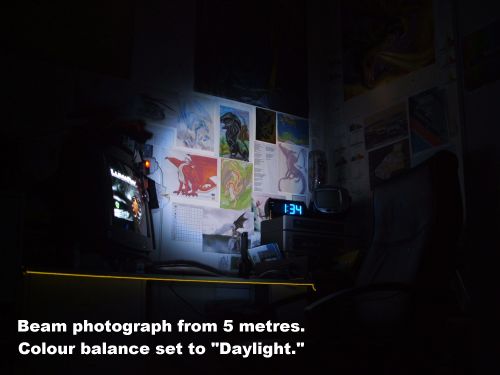
The original FL6 was no slouch where performance was concerned, though it was true that it was a bit of a big light for the amount of light it gave out - now however, it's brighter. Quite considerably brighter in fact! It's true that this isn't the absolutely brightest light of its size, even in its updated form. However, it was not designed to be the brightest thing possible - it was designed to be a useful tool. While a light with an output equal to the optical equivalent of a small atomic bomb may be a wonderful toy...if it only runs for 10 minutes on a set of batteries, it's not much use when your car breaks down and you need a light for two hours to fix it, is it? If you've got an FL6 with you though, you're sorted. It'll sit quite happily running for hours on end without even noticing.
As with the original FL6, the beam here is very narrow. Essentially a perfect white circle of light, surrounded by a slightly blue, sharply defined border. There is really very little spill light to speak of outside the main beam. Initially this will appear as quite a novel feature (especially if it happens to be a foggy night outside and you have the light handy...then you can play at being Luke Skywalker with your very own light sabre), but it does detract from the overall appeal of the light somewhat. The reason for this is simple - say you're in a room you don't know, and you've just turned on your FL6 - and have a door at the far end of the room lit up - you can see the door - but not the sofa, coffee table or light switch that you have to navigate past on the way there.
This new version isn't quite that bad, there is a LITTLE spill light now, enough to see your own feet at least, and prevent you tripping over things when navigating around the house - the reflected light from the main beam tending to help there too now that the light is that much more powerful than the original. I'd personally prefer a light with a lot more side spill than this however, if I were to be using it a lot outside, for instance navigating a treacherous mountain path or something.
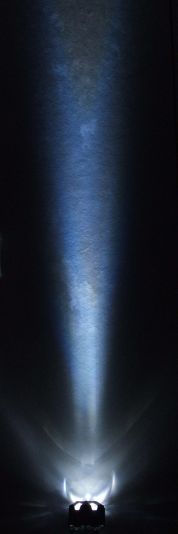
Beam Profile:
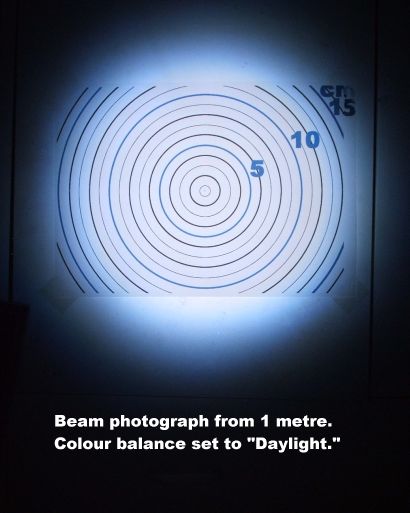
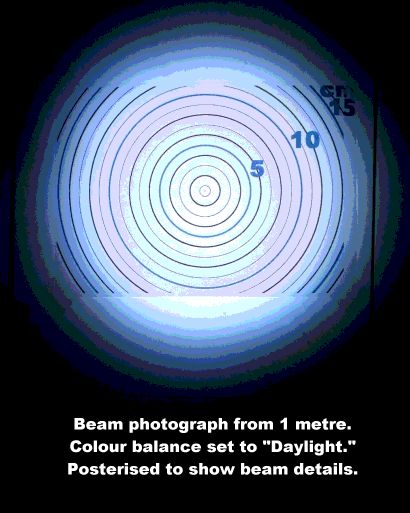
Lamps:

The FL6 - 2006 uses 6 5mm LED's to produce its cool white beam. These however are not the cheap and nasty bluish ones you see in the little £1 disposable keychain lights, they are the brightest and whitest Nichia CS series LED's - and really are rather bright.
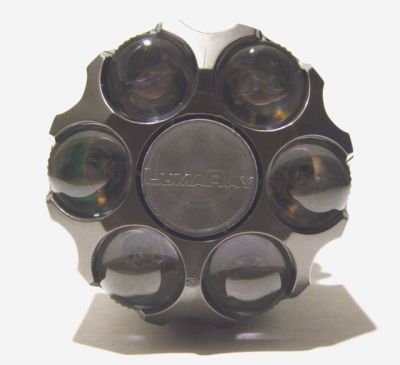
The LED's themselves however don't do all the work - the unusually narrow beam seen from the FL6 is achieved by the use of some rather clever optical design. A magnifying lens is placed in front of each individual LED, focused so that all six beams converge within a couple of feet of the light, producing the perfect circular beam seen here. The frosted white disc seen in the centre of the bezel does not actually play a part in producing light in this model of flashlight, with just some stray light from inside the optical system escaping here.
We all know the story - the power's just gone off, it's the middle of the night, there's no moon, you literally cannot see your hand in front of your face...and you know there's a flashlight somewhere...on the other side of the room. You then proceed to knock half the contents off of every shelf and flat surface in the vicinity, only to discover that it was actually sitting right next to where you started out. Just in time for the lights to come back on. Not with the FL6!

Deposited on the back of the light reflective "cells" behind the lenses of the FL6 is a glow in the dark compound. Once this is charged up, it will glow at a steadily decreasing brightness for around ten hours. It's not hugely bright, but it's not meant for seeing by - it's there to help you find the light in a dark room - which it does supremely well. My FL12 generally gets left on my nightstand face down, otherwise the glow will actually keep me awake at night, it is bright enough to make the ceiling visibly lighter. One change that has taken place here is the colour of the glowing compound. The original FL6 had a very distinctive blue-green locator glow, whereas the new 2006 version uses a pure green one. Not a major change, but I felt it was worth mentioning. The glow is initially a lot brighter than shown in the photograph here - this is how it appears after 30 minutes or so in darkness. I decided to use this, as it gives a more realistic idea of what the locator looks like actually in use.
Ergonomics:
This is where the most changes have been made to the already excellent design of the FL6. While I am not yet sure whether I think the changes are for better or worse from a visual point of view, there is no denying that it has made the light a far more user friendly tool.
Everything from the neck of the flashlight, just below the head release mechanism has been redone from scratch it would appear, whereas the head remains fundamentally unchanged - a good thing, as it was a design that was very hard to fault.
The handle now features a number of circular depressions, in addition to a light matt texture, these make the light quite easy to retain in situations where your hands may be wet or greasy. I use my FL12 quite a lot when working on the car, and have to admit that when you've got oil covered hands, the old body design could be a little on the slippery side.
The tailcap has also been totally redesigned. The old one while distinctive, was less than entirely pocket friendly, and I imagine somewhat expensive to manufacture. The new design is far more functional, offering three different points to which lanyards or anything else you may wish to secure to a flashlight may be attached. On some surfaces this seems to allow the light to be slightly more stable when stood on end - which given it has a slightly wider area on the ground, makes sense.
The light, while around 15mm shorter than the original FL6/12, it is still perfectly balanced, the balance point being that narrow section just below the head release mechanism.
There are some things which you just pick up and think "This feels right" - the FL6 is one of those things.

There are one handed lights, and there are two handed lights. This is one of the latter, unless you have a really strong thumb anyway. The head is quite stiff to turn to switch the light on/off, generally requiring the use of your other hand. This can be made somewhat easier by removing one of the two O-rings used for waterproofing - obviously though, this will reduce the water resistance of the flashlight. I'd just leave it as it is, it's not difficult to turn on/off so long as you use both hands. Periodically lubricating the O-rings with a couple of drops of silicone based lubricant will keep things moving smoothly.
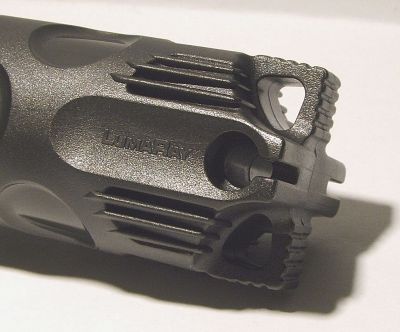
Durability Department:

Remember I told you not to judge the durability of this light on what it feels light straight out of the box? Well, you shouldn't. Once fully loaded with batteries, it feels really rather more substantial - which it is.
This may be a plastic bodied flashlight - but it's about as tough as they come. The body and head are made of an extremely resilient plastic called Xenoy™ made be GE. The body appears to be in the region of 1.5mm in thickness, meaning that this is quite probably MORE durable than a lot of cheap to mid range metal lights. The finish of the light around the handle is a light matt texture, this should prove relatively resilient to scratches, at least making them hard to see. The occasional scratch will probably appear in use, but you'd have to be trying pretty hard I reckon to actually break one of these lights!
The usual tests were conducted: First being the "normal" drop test, having the sample dropped from waist height onto a thinly carpeted wooden floor. Result, a moderately loud bang, and the cat shooting back out of the door she was about to walk in through. Second one is a throw test - throwing the light across the room from waist height, simulating having the light slip from my hand while running. The result of this was a far louder crash, but not so much as a flicker from the light.
As expected, water resistance proved to be excellent, the light showing no signs of trouble after spending two hours at the bottom of a full bathtub.
The only real issue with the original FL6/12 which made itself evident after some months of use was that it became somewhat prone to flickering when the light was moved, especially if pointing upward. Not a problem in any way, but somewhat irritating. This I believe was mainly due to the weight of the batteries compressing the spring in the barrel, momentarily moving their positive terminal from the "button" terminal in the head. This no longer seems to be an issue, as I was unable to make the new FL6 flicker, no matter how hard I shook it, the only way to get any reaction being to firmly tap the light on a hard surface when facing upward. While I was unable to note any difference in the spring used to maintain the positive contact, I did note that the return contacts (pictured to the right) are rather more prominent than on the original design of the light - this may actually be the cause for the reduction of flicker. Either way, this minor annoyance seems to be a bug which has now been eradicated from the design.

Overall:
LumaRay were setting themselves a tough challenge, improving on the original FL6, but they managed it. Seems that every little criticism I could come up with has been targeted, the lack of side spill aside - though the FL6's bigger brother, the FL12 did solve this (with style I might add), and I see no reason at this time not to expect to see an FL12 - 2006 later in the year.
This is a light which has had almost every detail I can think of thought out carefully. The head release mechanism while unusual, actually works very well once you've worked out how to make use of it (that's why it has instructions in the box!). The narrow beam is not going to be to everyone's tastes, but it does have its applications - one I recall pointing out in the original FL6 review was for people such as cinema attendants, as the narrow beam would cause the least disturbance to other people if use of the light was required. No doubt there are innumerable other applications for this sort of beam too.
Provided you're not looking for a light with a wide beam, I cannot really find fault with the FL6. It's durable, it's smart looking, it uses cheap everyday batteries - and runs for an eternity on them, and it's about as easy to use as they get. What more could you ask for?
Pros:
+Feels great in the hand
+VERY Long battery life
+Uses cheap easy to find batteries
+Water resistant
+Fairly light for its size
+Highly durable
+Glow-in-the-dark locator is a useful feature, and works.
Cons:
-Narrow beam angle can lead to tunnel vision in some situations.
Niggles:
>There is some light which can be seen leaking out of the back of the bezel when in operation, some people may find this objectionable.
>Switch can be somewhat hard to operate one handed if you have weak hands.
Ratings:
Beam Quality: 6
Build Quality: 10
Battery Life: 10
Durability: 9
Value: 8
Overall: 43 / 50 = 86%
Many thanks to Ed at LumaRay for providing this light for review!
Long Term Testing:
10th July 2006: Review uploaded.
10th July 2006: Now for something utterly random...apparently I'm not the only one who likes the FL6-2006. My cat also apparently fancies having one for herself, as the photograph below shows!

11th December 2006: Updated page formatting, following the discovery that the wrapping of text around images caused complete chaos to break loose when the page was viewed in anything other than a 1024*768 screen resolution.
7th December 2008: Removed links to the old server and sorted the dodgy page formatting.
5th January 2021: Page retired and moved to Site Archive.
28th April 2023: Revised Statcounter code to allow for HTTPS operation.
6th April 2025: Removed some dead links to the manufacturer's website which is no longer active.